Here's what it's like to ride in Ford's self-driving car
An autonomous Ford Fusion Hybrid took us for a spin... and we survived!

Ford is a mobility company. Yes, that's a marketing line, but after a 10 minute cruise in a self-driving Fusion Hybrid, we're starting to believe it. In short, Ford is hedging against a future where fewer people sink hard-earned cash into cars they have to drive, snapping up mass transit startups and getting into the business of moving people in unconventional ways.
This week, we plopped down in the rear seat of a Fusion Hybrid in Dearborn, Mich., the epicenter of all things Ford. Engineers had given the vehicle just two instructions: "Go there, and return here." With just two points on a map, the Fusion Hybrid was left to its own devices to find a way -- safely, of course -- to the first point, and then return to our originating spot.
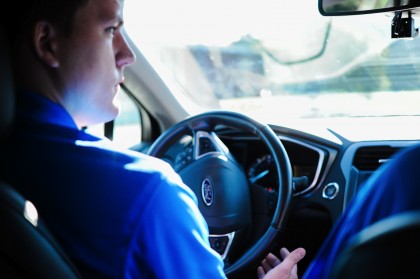
All told, the journey lasted around 10 minutes, and with two small exceptions, the car did every bit of the driving. Quite frankly, watching a car drive you on public roads just feels like the future. Much like using the internet on an airplane, we're pretty sure that folks alive right now will never not view the self-driving sensation as overwhelmingly novel.
A surreal experience
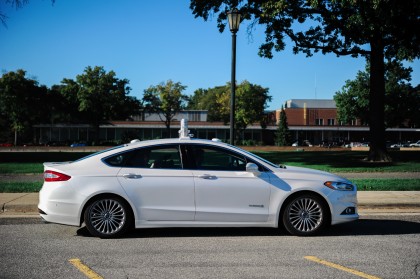
Our test ride was an off-the-shelf Ford Fusion Hybrid that was lightly augmented with LiDAR, a few cameras, and a handful of sensors. The combination enables the car to have a 360-degree view of its surroundings, with the ability to sense oncoming traffic and the like from about 80 yards away.
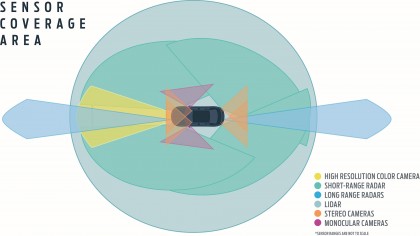
In talking with Dr. Ken Washington, vice president of Research and Advanced Engineering, he noted that Ford is working with Velodyne to at least double that viewability range within the next year or two.

It's shocking how little tech is visible on the car. It's rocking a foursome of nubs on the roof, a camera just behind the rear-view mirror, and an emergency stop button in the center console. Outside of those instruments, you'd be hard-pressed to notice that there was anything special about the sedan.
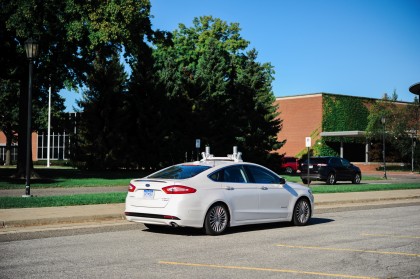
Ford did put a pair of engineers in the front seats, with one of those obviously behind the wheel. They stressed that the model we were sitting in was still in development, but that they wouldn't do anything to adjust the route unless they felt something was amiss.
Sign up for breaking news, reviews, opinion, top tech deals, and more.
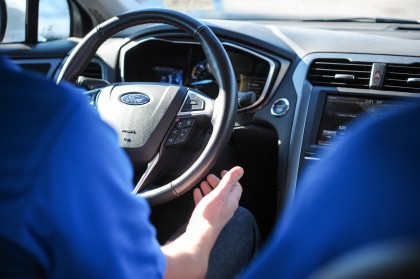
Ford had mapped out the area that we were driving ahead of time, embedding that information into the car. It already knew where pedestrian crosswalks were, where stoplights were, and where intersections were. But again, this wasn't a pre-programmed route; the car had a legitimate challenge in getting itself to the destination using the information taken in real-time by its sensors.
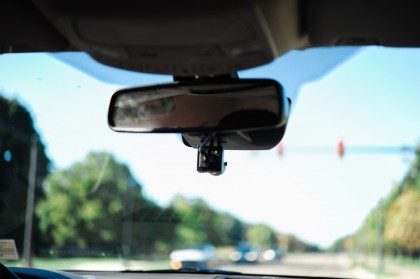
We watched the car navigate several miles without the driver lifting a finger (or foot, as it were). It intelligently slowed to a stop at a crosswalk in order to let employees saunter by; it spotted a stoplight turning yellow and halted us safely and smoothly at the proper point. It also maneuvered around a flowing left turn, which is said to be one of the most complex moves in all of driving. When there's no dedicated turn arrow, the car has to analyze a huge number of possibilities before it safely makes a left and crosses the intersection.
While we were traveling on open, public roads, speed limits were relatively low. We never left third gear, so far as we could tell, but the car managed to both accelerate and slow in a natural pattern. The goal here is to have the vehicle drive as if it were being driven by a highly trained human, which means that stutters, sudden halts, and sharp turns just aren't acceptable.
